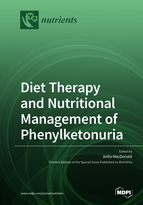Diet Therapy and Nutritional Management of Phenylketonuria
A special issue of Nutrients (ISSN 2072-6643). This special issue belongs to the section "Clinical Nutrition".
Deadline for manuscript submissions: closed (1 December 2021) | Viewed by 94840
Special Issue Editor
Interests: phenylketonuria; dietary treatment; protein substitutes; dietary adherence; feeding development
Special Issues, Collections and Topics in MDPI journals
Special Issue Information
Dear Colleagues,
Phenylketonuria (PKU) is an established inherited amino acid disorder with a very traditional dietary therapy, but there is still more to learn and verify about its nutritional composition, application and overall effectiveness. Although in the 1950s, the first patient successfully treated with diet therapy patently established the role of a low phenylalanine protein substitute, in present times, it is still necessary to characterise the most effective source of artificial protein; defining its optimal amino acid profile; and identifying nutrient modulation that will improve the functionality of protein substitutes. It is also important to understand the impact of a life-long synthetic diet on gut microbiota, metabolomics and inflammatory status.
In early-treated patients with PKU, it is unclear if co-morbidities such as overweight, obesity, hypertension and diabetes are higher than in the general population and if these are associated with increased cardiovascular risk. It is also uncertain if overweight and obesity in PKU is related to early dietary practices, the nutritional composition of protein substitutes and special low-protein foods, impact of the dietary treatment on satiety, disordered eating patterns, non-adherence with the low phenylalanine diet and poor metabolic control, or if this is even a consequence of the disorder. In a generation of ageing patients, the impact of intermittent and suboptimal dietary adherence on nutritional status deserves systematic study.
This Special Issue on dietary management of PKU shall bring together a collection of research articles that will advance knowledge in current areas lacking scientific clarity or with limited and incomplete evidence to support dietary practice.
Prof. Dr. Anita Macdonald
Guest Editor
Manuscript Submission Information
Manuscripts should be submitted online at www.mdpi.com by registering and logging in to this website. Once you are registered, click here to go to the submission form. Manuscripts can be submitted until the deadline. All submissions that pass pre-check are peer-reviewed. Accepted papers will be published continuously in the journal (as soon as accepted) and will be listed together on the special issue website. Research articles, review articles as well as short communications are invited. For planned papers, a title and short abstract (about 100 words) can be sent to the Editorial Office for announcement on this website.
Submitted manuscripts should not have been published previously, nor be under consideration for publication elsewhere (except conference proceedings papers). All manuscripts are thoroughly refereed through a single-blind peer-review process. A guide for authors and other relevant information for submission of manuscripts is available on the Instructions for Authors page. Nutrients is an international peer-reviewed open access semimonthly journal published by MDPI.
Please visit the Instructions for Authors page before submitting a manuscript. The Article Processing Charge (APC) for publication in this open access journal is 2900 CHF (Swiss Francs). Submitted papers should be well formatted and use good English. Authors may use MDPI's English editing service prior to publication or during author revisions.
Keywords
- Phenylketonuria
- Protein substitute
- Phenylalanine
- Amino acids







